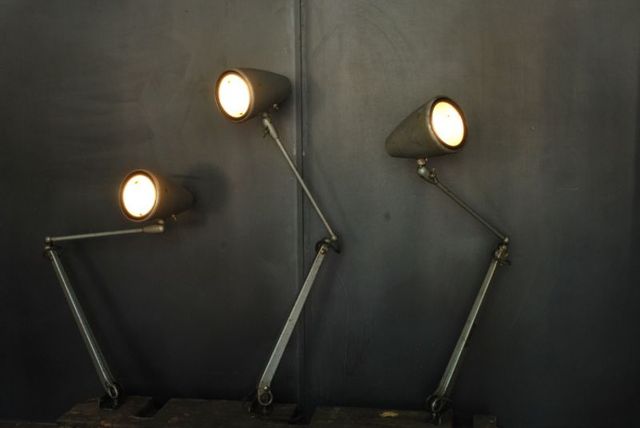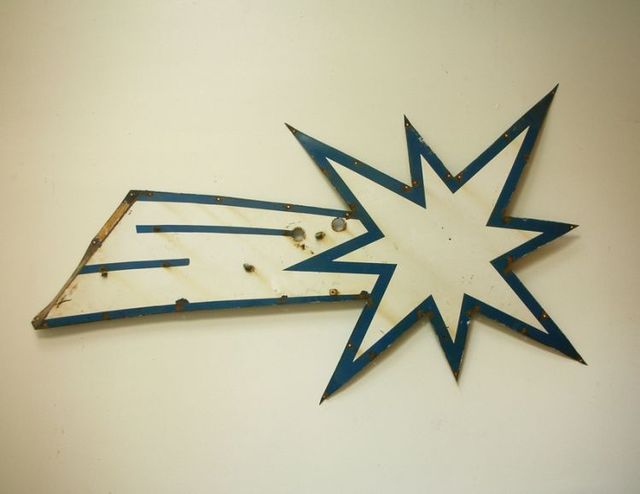Chicagoist Interview: Mariano Chavez at Agent Gallery
By Ben Schuman Stoler in Arts & Entertainment on Jul 9, 2010 8:20PM
When we walked into Agent Gallery on Damen Ave (between Augusta and Chicago), Mariano Chavez was working on some large planks of wedged wood that he was turning into bookcases. “This is my first commission to do a whole apartment,” he said, walking to his computer to show some photos. “Look. I suspended this old firefighter trampoline from the ceiling. Normally I just do lighting, I'm excited to do a whole loft.” Chavez said he preferred "Indirect, warm light," the kind of light that many of his fixtures provide. The Gallery, opened only since October of last year, is a tiny cramped space of such lights and nostalgic design pieces, but the website is a venerable catalog of explosion proof phones, factory lights, and a distinctively almost playful style of design. Along with Post 27 and Salvage One barely a mile away, Agent is a big part of Ukrainian Village’s developing design steeze.
We talked with the Art Institute of Chicago alum Chavez earlier this week about the advantages of being in Chicago, how he finds his pieces, and what defines his style.
Chicagoist: How do you feel about the city?
Mariano Chavez: I love Chicago a lot. I think because I’m in the arts a lot of my friends moved to LA or New York City and I’ve had friends try to get me to move. I think New York is a beautiful city but I don’t have any attraction to it.
C: Is Chicago a distinctively better or worse place to sell the kind of pieces you carry?
MC: New York is the best place to sell - a lot of my customers ship it out east. But to get it, the stuff is here. It’s scarcer and more in demand out east. It’s harder to get and the dealers out there are savvy and suck everything dry. The Midwest is great because there are so many factories here and old industrial, large buildings with lots of cool stuff. Indiana, Ohio, Illinois, there’s just so much stuff to find.
C: So do you mostly stay in the area?
MC: Yeah I look around town and I look online and then I also go around. I have other people in the business who scout out stuff for me. A lot of them don’t have stores, they just wholesale but the thing is I don’t just get whatever stuff they have. I’m really picky. A lot of times there has to be something to it, something catchy. It might actually be a bad thing - work against me. But for the sake of space the pieces I get have to have something special.
C: Is the competition to find pieces in Chicago particularly tough, or is there a community of buyers looking out for each other?
MC: There are certain people that are buyers and they sell to a lot of the same shops. I’ve started to move away from that because I want to be more unique. I know how it works now - I can just do it myself. It’s better because I want to be able to control what I get in the shop. It’s a lot more work but I get a more individual view and I get to go after what I want.
C: How do you feel about the romantic American style pushed by A Continuous Lean and others?
MC: There’s a simplification, definitely. And what’s tough is that a lot of this stuff is scarcer and scarcer to find. So many people are going after certain things. For instance right now those lockers are real hot - I could probably sell those every two weeks if I could find them but everybody wants them. So I’m trying to find things that are a little bit undiscovered. You have to adapt and evolve. Contractors and people that smash stuff now are also a little bit more conscious. They know what’s valuable. Before you could just go to a work site and grab stuff. Now the wreckers realize that thing is worth 1200 bucks or whatever.
C: What do you do to make sure that you’re not jumping on the style but setting the style?
MC: It goes back to simplicity. I’m always looking for stuff that’s basic, constant, with simple design, durable, great quality - and a lot of this factory stuff was built that way. All this factory stuff started picking up and got super trendy but at a certain point everyone was into midcentury modern and I didn’t really understand it because I thought it was really ugly. A lot of the factory stuff was interesting because it was designed by who knows, it’s super functional, it’s really durable, and it has a really nice look, it’s really understated because it was made for pure function. This light is just supposed to adjust and spot on my drill press or whatever. But now it has a nostalgic or romantic American imagery. It has that working class beauty to it.




